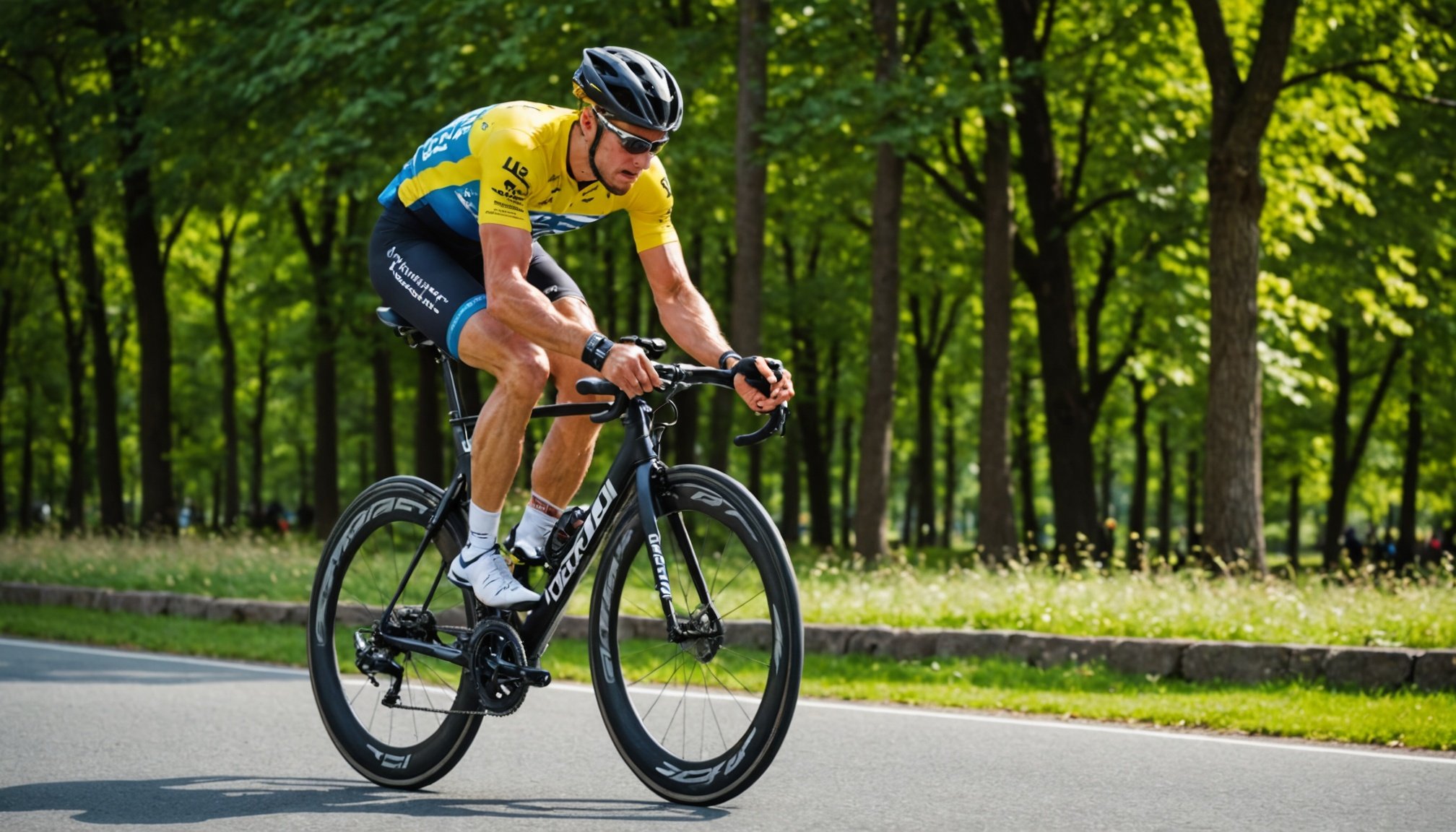Top Recovery Strategies to Combat Muscle Fatigue in Ultracycling: Your Ultimate Guide
Understanding Muscle Fatigue in Ultracycling
Ultracycling, whether it’s a gran fondo, a long-distance bikepacking trip, or an ultra-endurance race, pushes your body to its limits. Muscle fatigue is a common issue that endurance athletes face, and it’s crucial to understand its causes and consequences to develop effective recovery strategies.
Muscle fatigue in ultracycling is often the result of prolonged physical activity that depletes your glycogen stores, leads to muscle damage, and causes inflammation. Each pedal stroke, especially during long rides, involves a series of muscle contractions and relaxations that can lead to micro-tears in the muscle fibers. This process, combined with the repetitive impact and stress on your muscles, can result in significant muscle fatigue.
Also to read : Enhancing Fencing Performance: Proven Tactical Training Techniques to Boost Your Reaction Times
The Importance of Recovery in Your Training
Recovery is not just a passive process; it is an integral part of your training. When you’re preparing for an ultra-cycling event, your recovery strategies can make or break your performance.
“Recovery is the unsung hero of training,” says Laurent Bosquet, a renowned sports scientist. “Diminishing your training load allows your body to repair and become stronger than it was before. Resting and recovering properly will help you progress and achieve better results in your competitions.”
Have you seen this : Top Proven Techniques to Combat Heat Stress in Endurance Athletes
Here are some key recovery strategies to help you combat muscle fatigue:
Active Recovery
Active recovery involves engaging in low-intensity exercises that promote blood flow and help in the removal of waste products from your muscles without causing further strain.
- Cycling: Cycling, especially on a stationary bike or a flat terrain, is an excellent way to recover. It involves minimal impact and no braking contractions, making it ideal for active recovery[1][5].
- Swimming: Swimming, particularly the breaststroke and front crawl, works your muscles gently while improving blood circulation and reducing muscle soreness. It also helps in rehydrating the intervertebral discs, which can become dehydrated during intense cycling activities[1][5].
- Elliptical Trainer: The elliptical trainer mimics the motion of running but with less impact, making it another great option for active recovery. It engages the diagonal muscle chains similar to those used in cycling, which can help in transferring the benefits back to your cycling performance[1].
Strength Training
Incorporating strength training into your routine can significantly improve your endurance and reduce muscle fatigue.
- Core and Upper Body: Strengthening your core and upper body helps in stabilizing your posture and distributing the workload more evenly during long rides. Exercises like planks, rows, and shoulder presses can be particularly beneficial[1].
- Lower Body: While cycling primarily works your lower body, strength training can help in building resilience. Focus on exercises that target your glutes, hamstrings, and quads without overloading them[1].
Nutrition and Hydration for Recovery
Proper nutrition and hydration are essential for recovery. Here’s how you can fuel your body to aid in the recovery process:
Post-Ride Nutrition
After a long ride, it’s crucial to replenish your energy stores and support muscle repair.
- Carbohydrates and Protein: Consuming a mix of carbohydrates and protein within 30-60 minutes after your ride helps in replenishing glycogen stores and repairing muscle tissue. Aim for a ratio of 3:1 or 4:1 carbohydrates to protein[4].
- Electrolytes and Hydration: Rehydrating with electrolyte-rich drinks or foods can help replace lost salts and maintain proper hydration levels. Coconut water, sports drinks, or electrolyte tablets can be useful[4].
Daily Nutrition
Your daily diet plays a significant role in your overall recovery and performance.
- Balanced Diet: Ensure you have a balanced diet rich in complex carbohydrates, lean proteins, and healthy fats. Include foods high in antioxidants like berries, nuts, and leafy greens to help reduce inflammation[4].
- Supplements: Consider supplements like BCAA (Branched-Chain Amino Acids) and magnesium to support muscle recovery and energy production. However, always consult with a healthcare professional before adding any supplements to your diet[4].
Sleep and Rest
Sleep and rest are critical components of the recovery process.
Importance of Sleep
Sleep is when your body repairs and rebuilds muscle tissue, replenishes glycogen stores, and adapts to the demands of your training.
- Duration: Aim for 7-9 hours of sleep each night. For ultra-endurance athletes, additional naps during the day can also be beneficial[3].
- Quality: Ensure you have a consistent sleep schedule and a sleep-conducive environment to improve the quality of your sleep[3].
Rest Days
Rest days are not just about doing nothing; they are about allowing your body the time it needs to recover.
- Active Rest: On rest days, you can still engage in light activities like yoga or a leisurely walk to promote blood flow without exerting yourself[5].
- Complete Rest: Sometimes, it’s necessary to take complete rest days where you avoid any form of exercise. This allows your body to fully recover and rebuild[5].
Sample Recovery Plan
Here’s a sample recovery plan for an ultra-cycling event:
Weekly Recovery Plan
| Day | Activity | Duration |
|---|---|---|
| Sunday | Long Ride (Endurance) | 1.5 to 3 hours |
| Monday | Active Recovery (Upper Body Strength Training) | 1 hour |
| Tuesday | Interval Training (Endurance and Strength) | 1.5 to 2 hours |
| Wednesday | Cross-Training (Elliptical, Rowing, or Swimming) | 1 to 2 hours |
| Thursday | Long Ride (Endurance) | 1.5 to 3 hours |
| Friday | Active Recovery (Lower Body Strength Training) | 1 hour |
| Saturday | Rest or Light Activity | – |
| Sunday | Rest or Light Activity | – |
Pre-Competition Recovery
For the week leading up to a competition, it’s crucial to taper your training to allow your body to recover fully.
- 1 Week Before: Reduce your training volume by 50% for shorter distances (up to 10 km or sprint triathlons)[5].
- 2 Weeks Before: For medium distances (21 km or medium triathlons), reduce your training volume by 60% in the first week and 40% in the second week[5].
- 3 Weeks Before: For long distances (marathon or ultra triathlons), reduce your training volume by 60% in the first week, 40% in the second week, and 20% in the third week[5].
Practical Tips and Advice
Here are some practical tips to help you improve your recovery and performance:
Monitor Your Heart Rate
Using a heart rate monitor can help you gauge your intensity and ensure you’re not overexerting yourself during recovery sessions.
Listen to Your Body
Pay attention to your body’s signals. If you’re feeling excessively fatigued or experiencing pain, it may be a sign that you need to adjust your recovery plan.
Stay Flexible
Incorporate stretching and foam rolling into your routine to improve flexibility and reduce muscle soreness.
Recovery is a multifaceted process that involves active recovery, strength training, proper nutrition, hydration, sleep, and rest. By integrating these strategies into your training plan, you can significantly improve your performance and reduce muscle fatigue.
Remember, recovery is not just about resting; it’s about actively helping your body repair and adapt to the demands of ultracycling. With the right approach, you can ensure that your body is ready for the next long ride, helping you to achieve your ultra-cycling goals.
As you embark on your ultra-cycling journey, keep in mind that every small step in recovery can lead to significant improvements in your performance. So, take the time to recover, and watch your endurance and strength soar.






